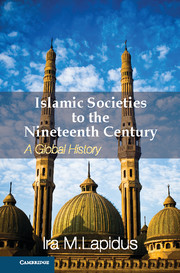Book contents
- Frontmatter
- Contents
- List of Illustrations
- List of Figures
- List of Maps
- List of Tables
- Preface
- Acknowledgments
- Acknowledgments to the first edition of A History of Islamic Societies
- Acknowledgments to the second edition of A History of Islamic Societies
- Publisher's Preface
- Introduction to Islamic Societies
- Part I The Beginnings of Islamic Civilizations
- The Middle East from c. 600 TO c. 1000
- The Preaching of Islam
- The Arab-Muslim Imperium (632–945)
- Chapter 5 Introduction to the Arab-Muslim Empires
- Chapter 6 The Arab-Muslim Conquests and the Socioeconomic Bases of Empire
- Chapter 7 Regional Developments: Economic and Social Change
- Chapter 8 The Caliphate to 750
- Chapter 9 The ʿAbbasid Empire
- Chapter 10 Decline and Fall of the ʿAbbasid Empire
- Cosmopolitan Islam: The Islam of The Imperial Elite
- Urban Islam: The Islam of Scholars and Holy Men
- Women, Families, and Communities
- Part II From Islamic Community to Islamic Society
- Part III The Global Expansion of Islam from the Seventh to the Nineteenth Centuries
- Glossary
- Bibliography
- Annotated Bibliography from A History of Islamic Societies, 2nd Edition
- Index
Chapter 5 - Introduction to the Arab-Muslim Empires
Published online by Cambridge University Press: 05 February 2013
- Frontmatter
- Contents
- List of Illustrations
- List of Figures
- List of Maps
- List of Tables
- Preface
- Acknowledgments
- Acknowledgments to the first edition of A History of Islamic Societies
- Acknowledgments to the second edition of A History of Islamic Societies
- Publisher's Preface
- Introduction to Islamic Societies
- Part I The Beginnings of Islamic Civilizations
- The Middle East from c. 600 TO c. 1000
- The Preaching of Islam
- The Arab-Muslim Imperium (632–945)
- Chapter 5 Introduction to the Arab-Muslim Empires
- Chapter 6 The Arab-Muslim Conquests and the Socioeconomic Bases of Empire
- Chapter 7 Regional Developments: Economic and Social Change
- Chapter 8 The Caliphate to 750
- Chapter 9 The ʿAbbasid Empire
- Chapter 10 Decline and Fall of the ʿAbbasid Empire
- Cosmopolitan Islam: The Islam of The Imperial Elite
- Urban Islam: The Islam of Scholars and Holy Men
- Women, Families, and Communities
- Part II From Islamic Community to Islamic Society
- Part III The Global Expansion of Islam from the Seventh to the Nineteenth Centuries
- Glossary
- Bibliography
- Annotated Bibliography from A History of Islamic Societies, 2nd Edition
- Index
Summary
The death of Muhammad and the Arab-Muslim conquests opened a new era in Middle Eastern civilizations. The Arab-Muslim conquests initiated the long historical process that culminated in the amalgamation of Arabia, the Sasanian Empire, and the eastern regions of the Byzantine Empire within an Islamic empire; in the eventual conversion of the majority of Jewish, Christian, and Zoroastrian peoples to Islam; and in the formation of an Islamic society and culture.
On Muhammad's death, many of his followers decided on the appointment of a caliph or executor of the Prophet's legacy. The first four caliphs – Abu Bakr (632–34), ʿUmar (634–44), ʿUthman (644–56), and ʿAli (656–61) – ruled by virtue of their personal connections with Muhammad and Arabian ideas of authority. They were later called the Rashidun, the Rightly Guided Caliphs. These caliphs, in part following the precedents set by Muhammad, launched a great wave of military campaigns and a migration of Arabian peoples leading to the conquest of all the lands of the former Sasanian Empire and the Near Eastern and North African provinces of the Byzantine Empire. Iraq, Syria, and Egypt were conquered by 641; Iran by 654. North Africa was conquered between 643 and 711; Spain between 711 and 759. In the east, the region of Inner Asia between the Oxus and the Jaxartes rivers, Transoxania, was fully conquered by 751. Thus, the “Middle East,” North Africa, Spain, and Transoxania were incorporated into a single empire. The Islamic religion and related cultures and an Islamic sociopolitical identity would be formed in this region.
- Type
- Chapter
- Information
- Islamic Societies to the Nineteenth CenturyA Global History, pp. 55 - 57Publisher: Cambridge University PressPrint publication year: 2012



